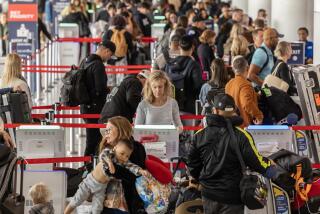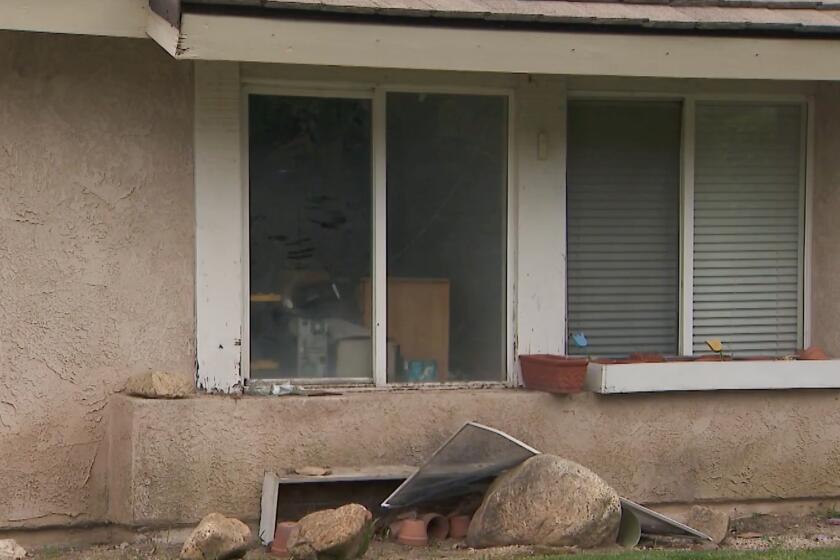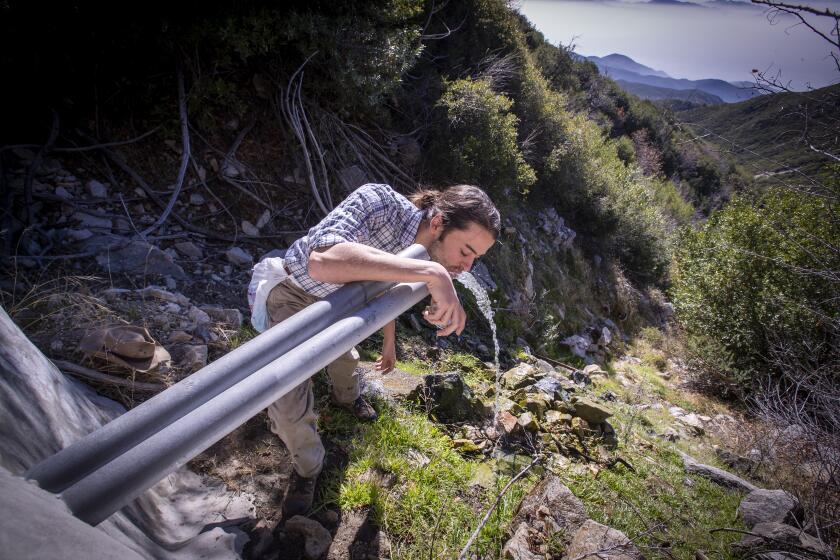The High of Mt. Lowe : Today Preservationists Celebrate the 100th Anniversary of a Historic Railway That Provided a Splendid Outing and Offered . . . : THE REGION
The first time Charles Seims hiked far into the Angeles National Forest above his home in Altadena, spooky ruins of a castle-like building loomed in the fog that shrouded Echo Mountain.
As a boy of 13 in 1958, he had no clue what once had been there. A few days later, on another hike, he found railroad tracks and power poles with overhead wires. “I was so excited I went down to Sears and bought a box camera on sale for $1.99 and went back up and started taking pictures,” he recalls.
No one--his teachers, parents or librarians--could explain what he had discovered. But eventually a school buddy told him about a railway that had journeyed into the clouds.
With that, Seims began to piece together the story of the Mt. Lowe Scenic Railway, which operated from 1893 to 1937 before succumbing to fire, flood, an earthquake, a rockslide, the Great Depression and the demise of rail transit. As an all-electric railroad traversing severe mountain slopes, it was considered one of the world’s engineering feats of the 19th Century.
Seims searched the canyons for buried treasure: railroad signs, trolley cars and the ruins of the railway’s resort hotels, where the rich, the famous and the ordinary visited as part of a sort of Disneyland ride into the sky. In 1976, Seims wrote a book about it.
But since then, Seims and other Mt. Lowe enthusiasts have worried that an out-of-print book is not enough to ensure that the memories and rich stories associated with the unusual railroad will endure.
The 100th anniversary today of its opening has spurred a renaissance of energy and restoration work surrounding the railway, developed by the eccentric Pasadena inventor and entrepreneur Thaddeus S. C. Lowe.
This year, Seims, now 49 and an attorney in Portland, Ore., revised his book, which is being reissued. And he has produced a video with footage of the trolley operating in the 1920s and 1930s.
Based on an application by Seims, the National Register of Historic Places included among its listings this year the portion of the railway site in the Angeles National Forest.
A group of 50 volunteers made up of Boy Scouts and members of the Pacific Railroad Society, as part of an effort sponsored by the U.S. Forest Service, have spent months clearing brush that obscured the foundations of trestles and the rail bed. The workers even found four sets of trolley wheels and eight feet of track still intact. And they have built a monument to the railway on Echo Mountain and are installing interpretive signs.
Today, at ceremonies in the Angeles National Forest and down below in Altadena, the Mt. Lowe enthusiasts will celebrate the centennial of the railway’s official opening on July 4, 1893.
On that date, the Pasadena City Band had the honor of riding in the first car on the cable car incline portion that went from Rubio Canyon above Altadena to Echo Mountain.
“The group began to play ‘Nearer My God to Thee,’ a subtle but unmistakable reference to the 1,500-foot vertical ascension. . . . It was an eerie but wonderful sight as the brilliant white cable car disappeared into a low bank of clouds,” Seims wrote in his book.
In an era of smoky, noisy steam engines, the electric-powered railway was seen as delightfully less polluting.
Restoring the few physical remains of the trolley is symbolically appropriate, said Seims, at a time when transit planners are trying to revive trains as a mass-transit option for Southern California.
And, Seims said, the restoration efforts are significant because the railway and its resorts were “the top tourist attraction in California after the turn of the century.”
As many as 1,500 people would make the trip in a day. Along the seven-mile route from Altadena to the base of Mt. Lowe, there were four hotels, with amenities that included billiards and card-playing rooms, a tennis court, a small zoo and an observatory.
The trip was divided into three parts: the first was the trolley ride from Altadena to Rubio Canyon. Then passengers would transfer to the cable car incline, designed by the man who would later build the San Francisco cable cars. Atop Echo Mountain, passengers would transfer back to a trolley car that traveled along hairpin curves to the base of Mt. Lowe, where there was a hotel, dining room and horseback-riding trails.
During its more than 40 years, the narrow-gauge railway attracted tourists from around the world, carrying 3.1 million passengers.
Adele Barnes was one among the millions. Born a month after the rail line opened, she fondly recalls the two times she rode the open-air cars. The first time she had come from upstate New York to visit friends in Pasadena.
“Here you were, with no effort on your part, gliding up the mountain. Like magic, you were drawn up into the air. The air was clean and the sky, bright. You had the mountains and the exhilaration of being up there. The train was packed with people, mostly tourists, and there was a grand camaraderie.”
The second time she rode it, in 1925, when she had left behind snowy New York for sunny Pasadena, she broke into a silly song that startled other passengers. “One woman smiled at me, like she was thinking: ‘Oh, you poor fool.’ But I couldn’t hold my excitement in.”
The Scenic Mt. Lowe Railway Historical Committee wants to pass on a sense of that excitement to the hikers, mountain bikers and horseback-riders who traverse the area from Altadena to Mt. Lowe. To that end, the committee is working with the Forest Service, which has allocated $10,000 to help repair the trails and put up signs.
About the same time the Seims book was published in 1976, the Forest Service posted some interpretive signs along the route. But those are now in need of repair.
The committee also wants to put up benches, publish a guide and perhaps even restore a portion of the trolley line with rails and the power poles and overhead lines. But Brian Marcroft, who is co-chairing the group, said that so far there isn’t enough money to do that.
If nothing is done to ensure that there are permanent reminders of the railway in the forest, Marcroft said, “we’re just afraid that the railway is just going to get lost to the public memory. It never has been taken care of since it was scrapped and dynamited years ago.”
When metal became precious during World War II, the rail line was sold for scrap. Then in the late 1950s and early 1960s, the Forest Service blew up the structures that hadn’t been torn apart, burnt up or washed away.
“To the Forest Service, historic preservation is to blow things up,” said Seims. As a teen-ager, he mailed a roll of toilet tissue to the Forest Service as a sign of his anger about the dynamiting of the burned ruins of the railway powerhouse that had looked like a castle to him in 1958 on Echo Mountain.
The Forest Service no longer sees dynamite as the solution, said Terry Ellis, the federal official in charge of the Arroyo Seco District, which encompasses the rugged terrain where the railway was. The railway, he said, is “an integral part of the history of the Angeles National Forest.”
That the Forest Service saw the ruins of railway structures as liabilities in the 1950s and 1960s “is history,” Ellis said. “There is nothing we can do about it.”
Now, he said, “we’re supportive of the volunteers’ efforts to celebrate and to make the railway more visible, so the public can enjoy a little bit of history about the forest.”
To Seims and Mike Manning, an Altadena print shop owner who is one of the organizers of the centennial celebration, the history of the railway is a heady elixir.
Walking along the steep trails formed by the rail bed, the men, both in their 40s, sounded like schoolboys Tuesday as they told stories of how the railroad came to be and how it met its downfall.
“It’s just the most beautiful place in the world to me. I’d rather be on Mt. Lowe than anywhere else,” Seims said as he strolled under a canopy of oak and spruce trees near the Mt. Lowe campground, where the foundations of the railway’s Ye Alpine Tavern still stand.
Seims and Manning met in the 1970s through a common interest in the railroad and a fascination with its mastermind, Thaddeus Lowe--who had a fourth-grade education.
The railway idea started when Lowe retired in Pasadena in the late 1880s. He built a 24,000-square-foot mansion with a commanding view of the San Gabriel Mountains.
Lowe had served the Union forces as a strategist in balloon warfare. As he looked to the mountains, he dreamed of building a railroad into the remote forest.
Having already made a fortune from inventions and patents dealing with steel, hydrogen gas and refrigeration, Lowe provided the money, and David Macpherson, a Pasadena engineer, provided the expertise to make the dream come true.
A crew of 50 men blasted through rock with dynamite and worked with picks and shovels. In less than two years the railway had reached Echo Mountain, and in two more it reached the base of Mt. Lowe.
“It literally had to be chiseled out of solid rock,” said Seims, surveying a granite canyon wall.
In its early years under Lowe, the trolley was expensive--$5 for a round trip to Mt. Lowe, while the trolley that ran between Los Angeles and Pasadena cost 10 cents.
“I don’t know if Lowe was arrogant, but he was a snob,” Seims said. “The railway was strictly for the rich and famous. Robin Leach would have loved it. It wasn’t for working-class people.”
The hotels and dinning rooms were among the most expensive and the best of their day. The dance halls became the center of the society scene in the mid-1890s.
The railroad was always crowded, Seims said, but the economy was suffering in the mid-1890s, and Lowe eventually lost the railway and resorts. They were taken over by rail and real estate magnate Henry Huntington, who merged them into his Pacific Electric trolley system.
The lower prices charged in the trolley’s later years made it possible for Virginia Bagnard to ride the railroad once in 1932 while the Great Depression engulfed the country. Her aunt in Pasadena paid the $2 fare for Bagnard, who was visiting from the small Imperial Valley town of Brawley.
As the train approached the Mt. Lowe end of the journey, it passed through the 3.5-mile stretch with 127 curves. “We were just hanging over nothing. But the view was spectacular,” said Bagnard, who now lives in Altadena.
The ride was one of the highlights of her life, she said. That’s why she plans to be among the celebrants at a lawn party along the former route of the trolley in Altadena today. She wanted to ride a shuttle bus on a Forest Service fire road into the San Gabriel Mountains and then make the .8-mile hike to Echo Mountain for festivities there. But at age 77, she said, heights make her dizzy.
Still, she will always cherish the ride on the railway into the clouds. “For a teen-ager from Brawley, it was something else.”
Celebration of Mt. Lowe
Two events today will celebrate the centennial of the Mt. Lowe Scenic Railway. The first takes place on Echo Mountain from 9 a.m. to noon. Monuments and plaques will be dedicated, and the 46-star U.S. flag that flew over the railway’s Ye Alpine Tavern will be raised. From 4 to 8 p.m. in Altadena, on the grassy strip where the railway once traveled along what is today Mt. Lowe Drive, there will be a lawn party and display of railroad memorabilia.
A Chronology of Mt. Lowe Scenic Railway
1890: Thaddeus S. C. Lowe, an inventor, Civil War balloon warfare strategist, and entrepreneur extraordinaire, retires to Pasadena and meets engineer David J. Macpherson, who like Lowe has his sights set on building a railroad into the San Gabriel Mountains.
1891: Lowe incorporates Pasadena & Mt. Wilson Railway Co., planning line to Mt. Wilson. Right-of-way difficulties force Lowe and Macpherson to aim for nearby Oak Mountain instead. Map-maker magnate Andrew McNally, who lives in Altadena and is a friend of Lowe’s, changes the name of Oak Mountain to Mt. Lowe.
1892: The San Gabriel Timberland Reserve, later to be called the Angeles National Forest, is established by President Benjamin Harrison. Railway construction is already under way on the public lands.
JULY 4, 1893: Official opening of railway and the Chalet hotel on Echo Mountain and the Rubio Pavilion hotel and dining room at Rubio Canyon.
1894: Echo Mountain House, a 70-room hotel, opens next to the smaller Chalet.
1895: Ye Alpine Tavern and hotel opens at base of Mt. Lowe.
1899: Despite solid ridership, Lowe loses control of railway because of difficulties in meeting loan payments on the expensive project, estimated to have cost at least $700,000.
1900: Echo Mountain House burns in electrical fire. Rail and real estate tycoon Henry Huntington buys the railway and links it to his Pacific Electric Red Car trolley line.
1905: Violent windstorm blows apart the Chalet hotel and other buildings at Echo Mountain.
1909: Flood and fire destroys Hotel Rubio.
1925: Mt. Lowe line becomes a subsidiary of the Southern Pacific Railroad.
1928: Gale-force winds blow down observatory at Echo Mountain.
1936: Ye Alpine Tavern burns.
1937: Railway booster club makes final run after the Mt. Lowe railway applies for state permission to abandon the line.
1938: The “Great Flood” hits Southern California, destroying much of the rail tracks. Line is officially abandoned.
More to Read
Start your day right
Sign up for Essential California for news, features and recommendations from the L.A. Times and beyond in your inbox six days a week.
You may occasionally receive promotional content from the Los Angeles Times.






